
The Origins and History of Carnival
Here is everything you need to know about the history and the origins of carnival, the world’s oldest party!
France
February 11 to March 1, 2026
Discover the Nice Carnival, the first international carnival in France and one of the most iconic festivities on the French Riviera! Every year, this spectacular event attracts thousands of visitors seeking to immerse themselves in a world of music, color, and joy.
With over 150 years of history, the Carnival transforms the streets of Nice into a carnival spectacle for two weeks, where dazzling float parades and live performances create a magical atmosphere that will leave you breathless.
Imagine being part of this unique celebration, where the streets come alive with parties and activities inviting you to sing, dance, and mingle. From dawn until dusk, the fun never stops.
Don’t miss the iconic Flower Parade, where impressive floats adorned with flowers dazzle everyone along the famous Promenade des Anglais. Feel the excitement as flowers are thrown into the crowd, creating a bond of joy and color that unites participants and spectators alike!
The Nice Carnival not only celebrates the arrival of spring but also offers you an unforgettable sensory experience. Come and be part of this extraordinary celebration that will leave an indelible mark on your heart!
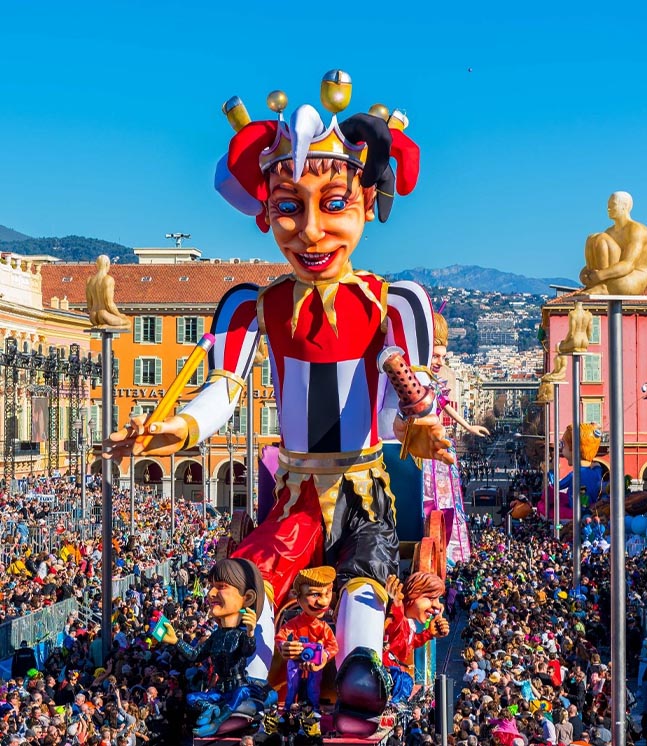
The Nice Carnival, one of the most emblematic events of the French Riviera in winter, is usually celebrated in February for two weeks full of color and joy, it is an experience you cannot miss.
Although the exact dates may vary each year, it is common for the carnival to take place in the last two weeks of February or early March, culminating in an impressive parade on the day before Ash Wednesday.
When will the Nice Carnival be held in 2026?
The Nice Carnival in 2026 will be held from February 11 to March 1. This annual event is famous for its parades like the Corsi Carnavalesques and the Batailles de Fleurs. In 2026, the theme of the carnival will be Long Live the Queen!, highlighting heroines from history and fiction.












The Carnival Parade is the central event of the Nice Carnival, featuring floats decorated with flowers, lights, and papier-mâché that travel through the city streets in a spectacle of great grandeur and beauty.
The floats are accompanied by musicians, dancers, and carnival-goers dressed in extravagant costumes and carnival masks, having themes and motifs ranging from the history and culture of Nice to fashion and technology.
The Carnival Parade is normally held on the afternoon of Wednesday and Thursday of the third week of February.
The Opening Ceremony of the Nice Carnival takes place at the iconic Place Masséna, in the heart of the city.
Enjoy a dazzling show with floats, dancers, musical groups, flag bearers, and masked artists coming together to provide you with an unforgettable experience.
The King, the Queen, and Carnavalon, along with our distinguished guests and the best international groups, present a unique show of the Nice Carnival. Don’t miss it!
At night, the spectacular Illuminated Parade takes place, with carnival floats adorned with dazzling lights that transform the atmosphere into an impressive visual spectacle.
The magic of the lighting enhances the beauty of the parade, while the artistic and musical groups entertaining along the route offer a true sound and light show that captivates all attendees.
Don’t miss this grand performance, which takes place on Saturdays and Tuesdays starting at 8:30 PM and lasts approximately an hour and a half at Place Masséna.
You cannot miss the spectacular Battle of the Flowers (Bataille de Fleurs), with stunning floats adorned with more than 250,000 flowers thrown into the audience.
This event is an explosion of colors and aromas that captivates everyone. Extraordinary costumes, vibrant music, and a magical atmosphere await you at the Place Masséna.
The performances, which last approximately an hour and a half, take place on Saturdays and Wednesdays in the afternoon.
The first gay carnival in France, inspired by the tradition of Nice festivities, is a popular event open to all, promoting the values of coexistence, inclusion, and sharing.
Lou Queernaval, since its inception in 2015, has attracted spectators from all regions of France and the world, marking the start of a weekend of exceptional festivities.
This unique, free event organized by the LGBTQIA+ community of Nice in collaboration with the city and the metropolis of Nice Côte d’Azur, brings together talented batucadas, dazzling drag queens, and artists delivering a powerful message of solidarity and benevolence, keeping alive the great popular tradition of the Nice Carnival with humility and a touch of madness.
Everything shines again at the Place Masséna with the Illuminated Parade, where illuminated carnival floats parade alongside artists and musicians animating the course with an unparalleled light and sound spectacle.
At the iconic Promenade des Anglais, the Nice Carnival concludes with the exciting burning of the King and a dazzling fireworks show, leaving an indelible mark and the promise of an even grander return next year.

With this colorful and different participation, we want to show diversity and spark the curiosity of our audience.Caroline Constantin, director of the Nice Carnival
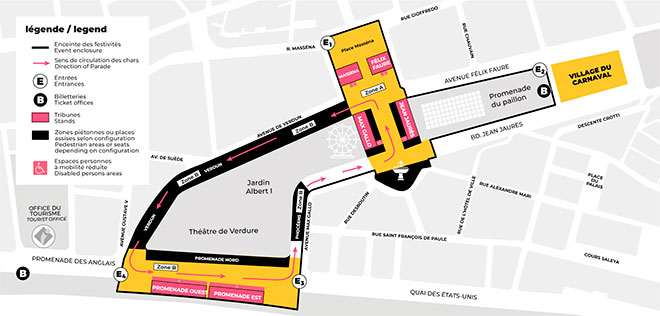
The Nice Carnival takes place in the city of Nice, on the French Riviera in France. The main events are mainly held on the famous Promenade des Anglais and at Place Masséna.
Nice, jewel of the French Riviera, is the capital of the Alpes-Maritimes region. Its location in the dazzling Bay of Angels, with views of the pebble beaches, makes this city not only offer stunning views but also be just 30 kilometers from the border between France and Italy, making it an ideal destination for those wanting to enjoy the carnival.
Zone A: Located in Place Masséna, it includes the Max Gallo, Jean Jaurès, Masséna, and Félix Faure stands. It features pedestrian areas at the foot of the Max Gallo and Jean Jaurès stands.
Zone B: Located between Avenue de Verdun and the Promenade des Anglais. It includes the Promenade West and Promenade East stands. It features three pedestrian areas: Avenue de Verdun, Promenade des Anglais, and the side of Jardin Albert Ier.
The Village: The carnival village is set up on the Promenade du Paillon, in the heart of Square Général Leclerc, near the ticket office and entrance E2, directly connected to the festivities.
Have you ever wondered about the fascinating history of the Nice Carnival?
The Nice Carnival, with roots dating back to 1294, is a vibrant celebration that has evolved over centuries.
In 1873, Andriot Saëtone founded the “Festival Committee“, marking the beginning of an era of festive splendor under the direction of Alexis Mossa. Since then, the Carnival has dazzled with its impressive floats and allegories, combining tradition and modernity, and has been recognized as cultural heritage by UNESCO.
In 1876, the dazzling flower parades, inspired by the poet and gardener Alphonse Karr, added a poetic and elegant touch to the celebration.
Over the years, the Carnival has faced challenges, such as the world wars, but has always emerged stronger.
Since 2005, the theme of the flower parades has aligned with that of the Carnival, ensuring that this unique celebration remains a symbol of creativity and joy.
The Nice Carnival, one of the largest in the world, attracts crowds every year with its dazzling parades in Place Masséna and the Albert 1st garden. With impressive floats, giant automata, and vibrant music, this carnival is the third most famous on the planet, after those of Rio de Janeiro and Venice.
The “Ymagiers” bring the floats to life through a creative process that combines tradition and modernity. During the parade, the audience marvels at the majesty of the King and the Queen, while the illuminated floats ignite the hearts of everyone.
The King of the carnival and his Court, created by the talented Alexis and Gustav-Adolf Mossa, come to life in the iconic Place Masséna.
The King inaugurates the festivities by receiving the keys to the city, leading a parade with his impressive float reaching up to 15 meters high.
By his side is the Queen, who debuted in 1893, and her son Carnavalon, the prince who joined in the 1930s, forming a royal family that symbolizes the magic of the carnival.
The Flower Parade is an event featuring fifteen floats adorned with flowers and artists that energize the celebration.
Since its inception in 1876, this parade has evolved to honor and showcase the floral diversity of the region, utilizing 80% locally grown flowers.
Each year, 100,000 flowers and 20 tons of mimosa are thrown into the audience, while each float is decorated with 3,000 fresh flowers. This event is an unparalleled celebration you cannot miss.
Nice takes pride in its rich cultural heritage, symbolized by the eagle, which adorns its coat of arms and represents its football team, and the dragon Babau, a 32-meter wonder that roams the carnival parades.
The Ratapignata, an inverted symbol of the eagle, highlights the intelligence and perception of the nizzardos against the dark forces, while the cat Raminagrobis, prince of felines, was honored as His Majesty of the Carnival in 2008.
These icons not only celebrate Nice’s identity but also invite everyone to join in celebrating its exceptional cultural legacy.

If you have no idea what to do, places to visit, where to stay, where to eat, how to get there, or what to bring to not miss the Nice Carnival, don’t worry! Here we tell you everything you need to know.

What to do at the Nice Carnival? During the Carnival, you can enjoy a variety of exciting activities. Attend the parade of floats decorated and full of color, accompanied by musicians and dancers.
Don’t miss the Flower Battles on the Promenade des Anglais, where flowers are thrown from the floats. Explore the Carnival Village in the Place Masséna, where you will find live entertainment and food stalls.
Additionally, you can enjoy the panoramic view from the Colline du Château and stroll through the flower market at Cours Saleya. It’s a unique experience!

What to see at the Nice Carnival? Don’t miss the main parades, known as Corsi, which take place both during the day and at night and feature creatively and colorfully decorated floats.
Another highlight is the Flower Battles, where flowers are thrown from the floats to the audience.
The key locations of the carnival are Place Masséna and Promenade des Anglais, where a festive and vibrant atmosphere can be felt. Additionally, the carnival culminates with a spectacular fireworks display.

Where to stay during the Nice Carnival? You have several accommodation options. You can choose luxury hotels like the Hotel Negresco, known for its elegance and location on the Promenade des Anglais.
If you prefer something more economical, the Hotel La Villa Nice Victor Hugo is a good option, as it is comfortable and close to the center.
For a unique experience, you might consider staying in a bed and breakfast in the old town, like the Palais Saleya Boutique Hôtel. There are also holiday apartments that allow you to enjoy more space and flexibility.

Where to eat at the Nice Carnival? During the Nice Carnival, you have many options to enjoy local cuisine.
You can try Cuisine Nissarde at restaurants like La Merenda, famous for its traditional dishes. If you’re looking for something more sophisticated, Le Chantecler, in the Hotel Negresco, offers a gourmet experience with two Michelin stars.
For a more casual option, Chez Pipo is known for its delicious socca, a local specialty. You can also explore local markets, like Cours Saleya, where you will find fresh produce and prepared food. Enjoy your meal!

How to get to the Nice Carnival? Here are the different options you have. One of them is to fly to Nice Côte d'Azur Airport, which is only 7 km from the city center. From there, you can take a taxi, a bus, or the tram to the city center.
If you prefer train, the Nice-Ville station is well connected to other French and European cities. You can also arrive by car via the A8 motorway. Once in Nice, getting around is easy thanks to the local tram and bus system.

What to bring to the Nice Carnival? It is essential to wear comfortable clothing suitable for the winter weather, such as a warm jacket. Don’t forget to bring a mask or a costume to join in the fun.
Make sure to bring a camera or a smartphone to capture special moments. It’s also helpful to carry cash for purchases at markets and food stalls. An umbrella or raincoat may come in handy in case of rain.
Finally, don’t forget to bring sunscreen and sunglasses for sunny days.

Here is everything you need to know about the history and the origins of carnival, the world’s oldest party!

The Tenerife Carnival is the biggest party in Europe. Here are the best suggestions to have the time of your life.

Masks throughout history have been one of the most sacred objects for many civilizations. To understand why they are, it is necessary to delve into their history.

Rio de Janeiro Carnival is the biggest & most famous carnival celebration in the world. Rio hosts the world-famous parades, street parties & masquerade balls.

Everyone knows Rio Carnival, but here are some of the other best places around the world where you can celebrate carnival.
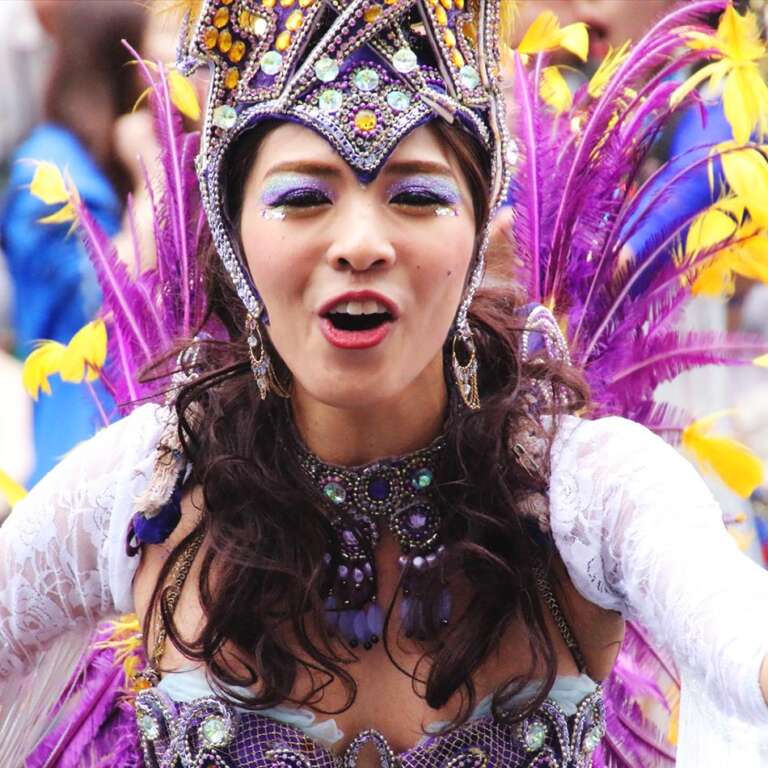
From late August to mid-September 2025
Let yourself be carried away by the magic of Brazilian samba on the streets of Japan.

The carnival will be celebrated in June 2025
Hollywood Boulevard becomes a Caribbean-American paradise to the rhythm of samba, soca, and reggae.
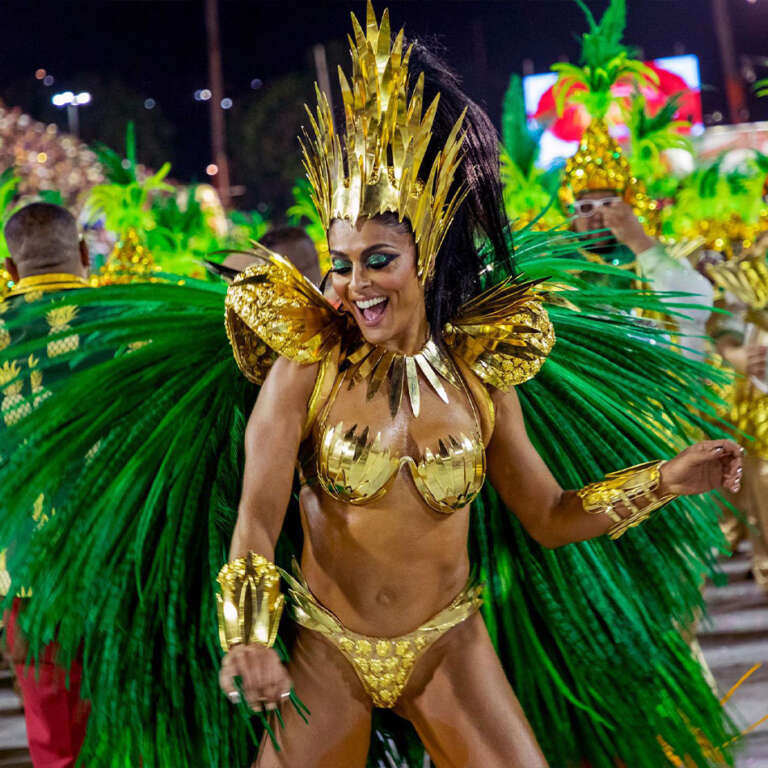
February 13th to February 21st, 2026
Parades, samba, blocos, street parties, masked dances, and nightlife.
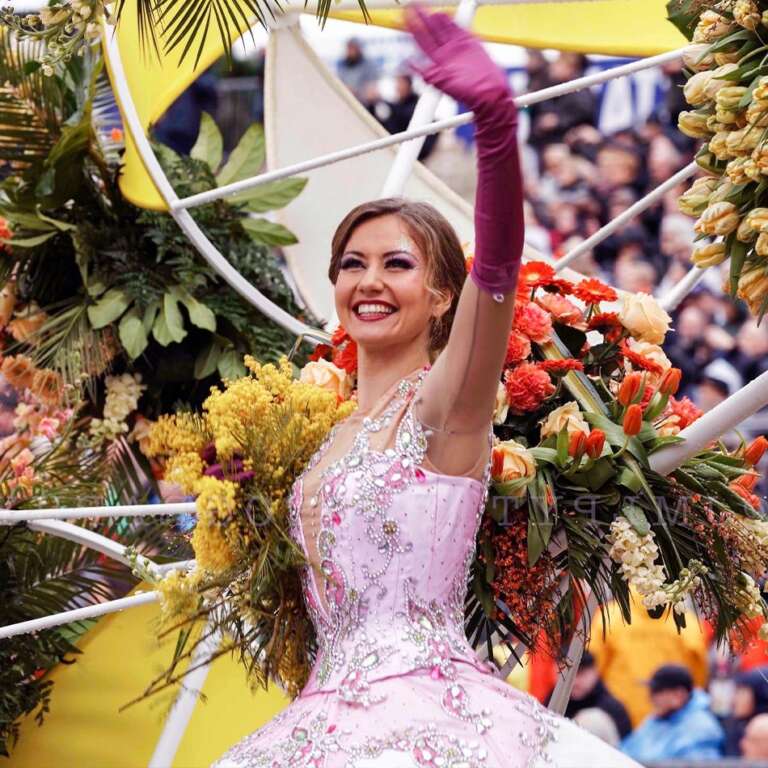
February 11 to March 1, 2026
You will be amazed by a shower of over one hundred thousand flowers falling from the sky.
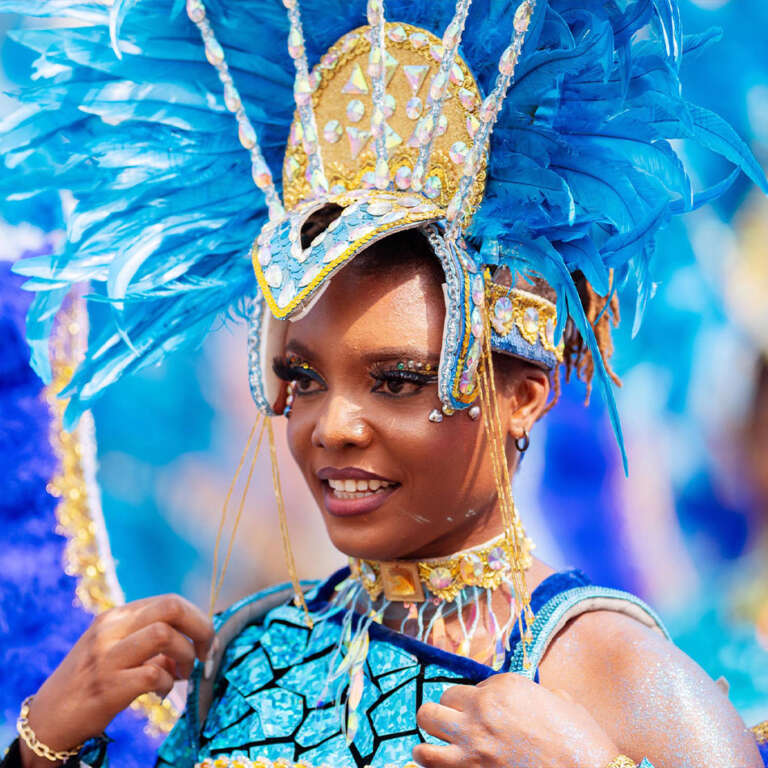
December 1 to December 31, 2025
Over two million tourists visit the Calabar carnival every year, the pride of Nigeria.
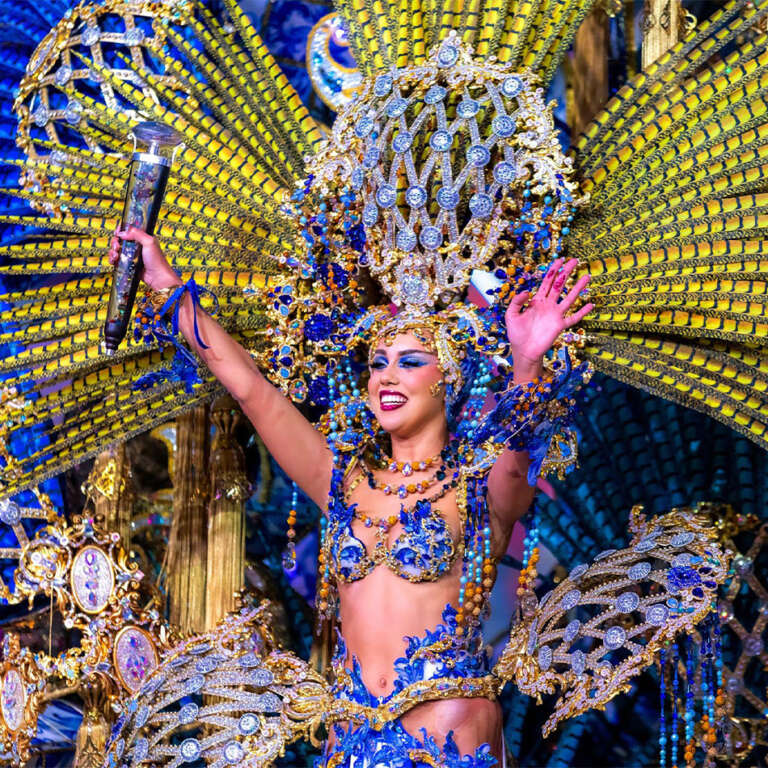
January 16 to February 22, 2026
More than 250,000 people visit Santa Cruz in Tenerife to celebrate the carnival.